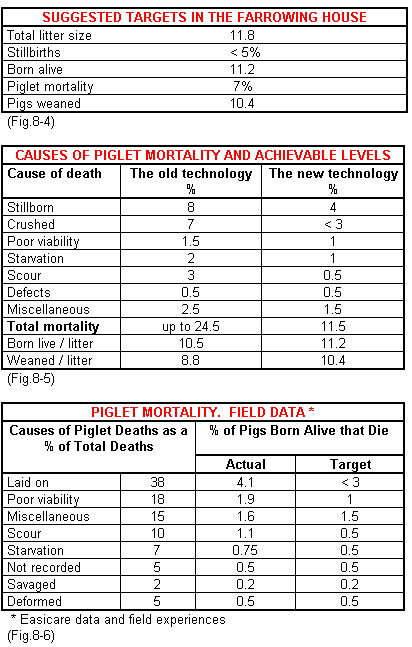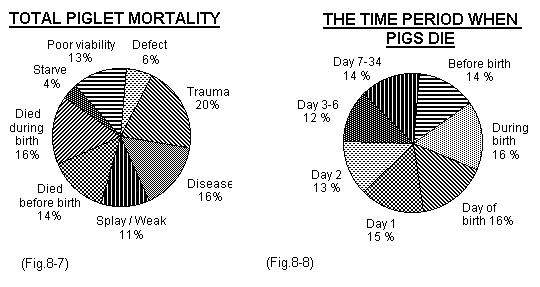



Records
Records should provide two types of information, end data which identifies what is being achieved, and epidemiological data which gives the detailed components that have been responsible for this achievement. End data on its own is not of great value in understanding a problem. There must be the facility to collect, examine and learn from the components. For example, 3% piglet mortality due to diarrhoea is of little value in helping to decide action without the knowledge of the sows involved, their parity and the age of the deaths. Within the management system of the farrowing house, detailed observations and time scales should be recorded on the sow and litter cards. Such information will help you to understand a problem if it arises. Records identify achievements that can be assessed against target levels of efficiency.
Fig.8-4 shows targets that should be achieved using a modern breeding female in an indoor system.
If a 7% piglet mortality is to be achieved it is necessary to both identify and document the reasons for the losses. Fig.8-5 shows the type of results that can be achieved in herds using management principles described in this chapter, compared to herds that are not applying them. The major differences are the higher stillbirth rates and more piglets that are crushed or laid on. A good management system also produces lower mortality associated with poor viable piglets, starvation and in particular it controls losses from scour and miscellaneous conditions.
Information from indoor production (Fig.8-6) shows that piglets laid on and those of poor viability account for major losses followed by miscellaneous causes and scour. However piglet mortality must also include deaths that occur both pre-farrowing and during the farrowing period.

Fig.8-7 shows the total distribution of pre-weaning mortality and Fig.8-8 the time scale when this occurs. It is a sobering thought that 30% of the pigs that die do so before or during birth and 44% within the first two days of farrowing. This information highlights the importance of management inputs immediately before and for the first 48 hours after farrowing.
The categorisation of piglet mortality as shown is based on observations, but accurate figures on born dead are difficult because some die in utero and others during farrowing. On some farms however, despite considerable efforts, piglet mortality remains high and in these cases it is necessary to carry out a piglet mortality survey. This involves the post-mortem examinations of all the piglets that die over a period, for example one month, with each piglet being documented back to the dam the litter size and the fostering carried out. Clinical observations recorded on the sow and litter card together with the post-mortem findings then help in determining corrective action. It is also helpful to differentiate between a poor viability or a low birth weight pig and one that has the capability of surviving with assistance. If a sucking reflex can be felt by placing the little finger at the back of the tongue the piglet has a chance of survival.






